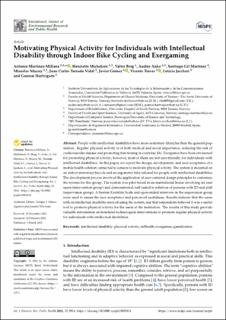| dc.contributor.author | Martinez-Millana, Antonio | |
| dc.contributor.author | Michalsen, Henriette | |
| dc.contributor.author | Berg, Valter | |
| dc.contributor.author | Anke, Audny Gabriele Wagner | |
| dc.contributor.author | Martinez, Santiago | |
| dc.contributor.author | Muzny, Miroslav | |
| dc.contributor.author | Torrado, Juan Carlos | |
| dc.contributor.author | Gomez, Javier | |
| dc.contributor.author | Traver, Vicente | |
| dc.contributor.author | Jaccheri, Maria Letizia | |
| dc.contributor.author | Hartvigsen, Gunnar | |
| dc.date.accessioned | 2022-09-27T11:24:14Z | |
| dc.date.available | 2022-09-27T11:24:14Z | |
| dc.date.created | 2022-03-07T13:40:48Z | |
| dc.date.issued | 2022 | |
| dc.identifier.issn | 1661-7827 | |
| dc.identifier.uri | https://hdl.handle.net/11250/3021747 | |
| dc.description.abstract | People with intellectual disabilities have more sedentary lifestyles than the general population. Regular physical activity is of both medical and social importance, reducing the risk of cardiovascular disease and promoting functioning in everyday life. Exergames have been envisioned for promoting physical activity; however, most of them are not user-friendly for individuals with intellectual disabilities. In this paper, we report the design, development, and user acceptance of a mobile health solution connected to sensors to motivate physical activity. The system is mounted on an indoor stationary bicycle and an ergometer bike tailored for people with intellectual disabilities. The development process involved the application of user-centered design principles to customize the system for this group. The system was pilot-tested in an institutional house involving six end-users (intervention group) and demonstrated/self-tested to relatives of persons with ID and staff (supervision group). A System Usability Scale and open-ended interview in the supervision group were used to assess the user acceptance and perceived usefulness. Results indicate that the users with an intellectual disability enjoyed using the system, and that respondents believed it was a useful tool to promote physical activity for the users at the institution. The results of this study provide valuable information on beneficial technological interventions to promote regular physical activity for individuals with intellectual disabilities. | en_US |
| dc.language.iso | eng | en_US |
| dc.publisher | MDPI | en_US |
| dc.rights | Navngivelse 4.0 Internasjonal | * |
| dc.rights.uri | http://creativecommons.org/licenses/by/4.0/deed.no | * |
| dc.title | Motivating Physical Activity for Individuals with Intellectual Disability through Indoor Bike Cycling and Exergaming | en_US |
| dc.title.alternative | Motivating Physical Activity for Individuals with Intellectual Disability through Indoor Bike Cycling and Exergaming | en_US |
| dc.type | Peer reviewed | en_US |
| dc.type | Journal article | en_US |
| dc.description.version | publishedVersion | en_US |
| dc.source.volume | 19 | en_US |
| dc.source.journal | International Journal of Environmental Research and Public Health (IJERPH) | en_US |
| dc.source.issue | 5 | en_US |
| dc.identifier.doi | 10.3390/ijerph19052914 | |
| dc.identifier.cristin | 2008065 | |
| cristin.ispublished | true | |
| cristin.fulltext | original | |
| cristin.qualitycode | 1 | |

